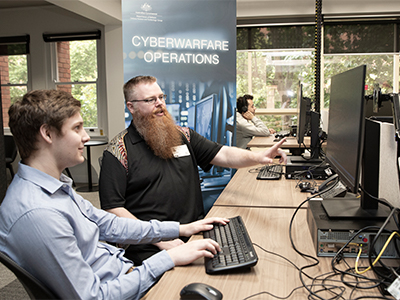Out of the classroom, into real world cyber

An information warfare summer school.
Another week, another cyber security scare on the news; it’s no surprise that Defence and national security organisations have a growing need for cyber specialists.
But it’s a highly competitive market out there for skilled graduates. As part of DSTG’s attempt to increase the cyber STEM pipeline and to boost awareness of DSTG involvement in information warfare (IW), an IW Summer Scholarship Program has again been held to sponsor university engagement during the summer university break. Over a 12 week period, University of Adelaide engineering and computer science students have been paired with DSTG researchers and tasked with actively investigating applied problems in the Defence priority theme of Information Warfare.
During the program, students and researchers have been based at Lot 14’s newly-redeveloped Eleanor Harald Building. It’s a short walk from the university’s city campus, though changing COVID restrictions in late 2021 have meant face-to-face involvement has been reduced to virtual alternatives where possible.
Across 11 projects led by Defence researchers, students got a small taste of what a career in Defence R&D might be like, including unclassified examples of the tough S&T challenges faced. These current Defence stakeholder challenges cover topic areas such as data mining, adversarial machine learning, deceptive cyber defence and watermarked network traffic. Upon completion of the program this month, the students will present their projects back to Defence and University of Adelaide stakeholders.
Identifying signals in a congested environment
Branko Vanjorek recently completed a Masters in Machine Learning at the University of Adelaide. During the IW Summer Scholarship Program he worked with Defence researcher Dr Julian Sorensen on a project relevant to the electronic warfare domain, identifying individual signals in a congested communications environment.
“We’re describing the transmission times of unknown signals as a graph, and identifying subgraphs to inform us how many unique signal sources are out there,” says Branko. The challenge, Dr Sorensen explains, is that there are many signals being received by an antenna that are difficult to differentiate. While this is a fairly traditional communications challenge, our approach is taken from a completely different angle. And it’s been useful to have Branko take a closer look at different techniques and see which ones are most promising.
“I’ve really enjoyed taking what I am learning at university and applying it to a real-life situation,” says Branko. “Simulations and the whole nature of trial and error research were new to me. Usually our university work has straightforward answers. With work like this, there’s a lot of exploration, discussion and collaboration. And it’s all right if something doesn’t work. That’s quite a difference.”
Dr Sorensen touched base with Branko several times each week, and whenever his advice was sought. The results complement a related project underway with Lockheed Martin’s STELaRLab, work which fits into the Information Warfare STaR Shot.
Self-help for machine-learning models
Ethan Selway, a second-year University of Adelaide software engineering student, has worked with Defence researcher Mr Tim Pitts to develop algorithmic techniques that help a machine learning (ML) system defend itself.
“The work has definitely felt more practical and purposeful, which is great. University work is often a more tokenistic exercise,” says Ethan. “What I’ve done in this summer school feels like it’s going towards achieving something. Following this program and after having a better idea of how Defence operates, I’m leaning towards a career in Defence.
“We’re taking on more and more machine-learning in our everyday environment,” says Mr Pitts. “The kinds of applications that Ethan has developed are going to be essential for things like self-driving cars. And we can take them further into applications relevant to Defence.”
Mr Chris Gobbett, DSTG Cyber Program and Partnerships Manager, explains that developing meaningful projects for summer school programs like this is a challenge for defence scientists working on classified projects. “Creativity is needed to come up with an abstract yet unclassified problem that will allow us to interface with universities or industry. And then take what students like Ethan and Branko have done, for example, and incorporate them back into more classified, Defence-specific applications. But it’s definitely worth the effort, and we hope to continue this program next year.”

